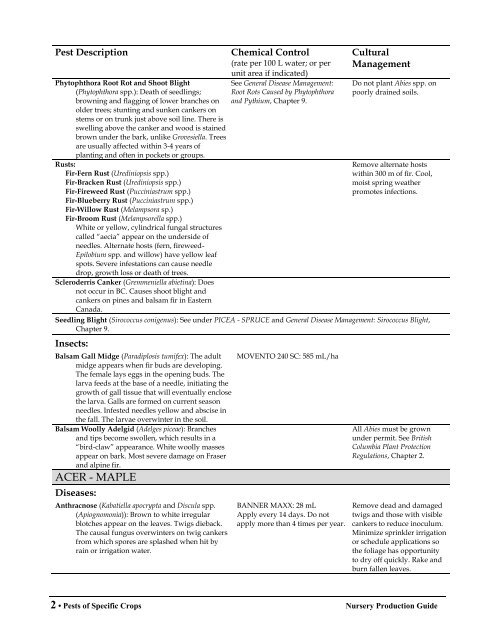Create successful ePaper yourself
Turn your PDF publications into a flip-book with our unique Google optimized e-Paper software.
Pest Description<br />
Phytophthora Root Rot and Shoot Blight<br />
(Phytophthora spp.): Death <strong>of</strong> seedlings;<br />
browning and flagging <strong>of</strong> lower branches on<br />
older trees; stunting and sunken cankers on<br />
stems or on trunk just above soil line. There is<br />
swelling above the canker and wood is stained<br />
brown under the bark, unlike Grovesiella. Trees<br />
are usually affected within 3-4 years <strong>of</strong><br />
planting and <strong>of</strong>ten in pockets or groups.<br />
Rusts:<br />
Fir-Fern Rust (Urediniopsis spp.)<br />
Fir-Bracken Rust (Urediniopsis spp.)<br />
Fir-Fireweed Rust (Pucciniastrum spp.)<br />
Fir-Blueberry Rust (Pucciniastrum spp.)<br />
Fir-Willow Rust (Melampsora sp.)<br />
Fir-Broom Rust (Melampsorella spp.)<br />
White or yellow, cylindrical fungal structures<br />
called “aecia” appear on the underside <strong>of</strong><br />
needles. Alternate hosts (fern, fireweed-<br />
Epilobium spp. and willow) have yellow leaf<br />
spots. Severe infestations can cause needle<br />
drop, growth loss or death <strong>of</strong> trees.<br />
Scleroderris Canker (Gremmeniella abietina): Does<br />
not occur in BC. Causes shoot blight and<br />
cankers on pines and balsam fir in Eastern<br />
Canada.<br />
Chemical Control<br />
(rate per 100 L water; or per<br />
unit area if indicated)<br />
See General Disease Management:<br />
Root Rots Caused by Phytophthora<br />
and Pythium, Chapter 9.<br />
Cultural<br />
Management<br />
Do not plant Abies spp. on<br />
poorly drained soils.<br />
Remove alternate hosts<br />
within 300 m <strong>of</strong> fir. Cool,<br />
moist spring weather<br />
promotes infections.<br />
Seedling Blight (Sirococcus conigenus): See under PICEA - SPRUCE and General Disease Management: Sirococcus Blight,<br />
Chapter 9.<br />
Insects:<br />
Balsam Gall Midge (Paradiplosis tumifex): The adult<br />
midge appears when fir buds are developing.<br />
The female lays eggs in the opening buds. The<br />
larva feeds at the base <strong>of</strong> a needle, initiating the<br />
growth <strong>of</strong> gall tissue that will eventually enclose<br />
the larva. Galls are formed on current season<br />
needles. Infested needles yellow and abscise in<br />
the fall. The larvae overwinter in the soil.<br />
Balsam Woolly Adelgid (Adelges piceae): Branches<br />
and tips become swollen, which results in a<br />
“bird-claw” appearance. White woolly masses<br />
appear on bark. Most severe damage on Fraser<br />
and alpine fir.<br />
ACER - MAPLE<br />
Diseases:<br />
Anthracnose (Kabatiella apocrypta and Discula spp.<br />
(Apiognomonia)): Brown to white irregular<br />
blotches appear on the leaves. Twigs dieback.<br />
The causal fungus overwinters on twig cankers<br />
from which spores are splashed when hit by<br />
rain or irrigation water.<br />
MOVENTO 240 SC: 585 mL/ha<br />
BANNER MAXX: 28 mL<br />
Apply every 14 days. Do not<br />
apply more than 4 times per year.<br />
All Abies must be grown<br />
under permit. See British<br />
Columbia Plant Protection<br />
Regulations, Chapter 2.<br />
Remove dead and damaged<br />
twigs and those with visible<br />
cankers to reduce inoculum.<br />
Minimize sprinkler irrigation<br />
or schedule applications so<br />
the foliage has opportunity<br />
to dry <strong>of</strong>f quickly. Rake and<br />
burn fallen leaves.<br />
2 • <strong>Pests</strong> <strong>of</strong> <strong>Specific</strong> <strong>Crops</strong> Nursery Production Guide
















